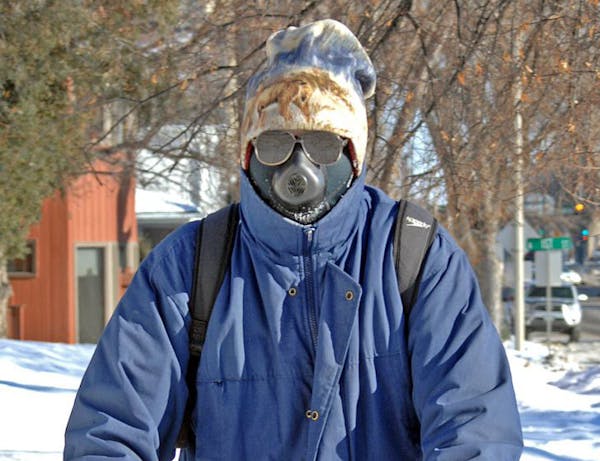As Minnesotans brace for a blizzard on the first official day of winter — and the arctic blast that's expected to follow — Jeffrey Love has a message for anybody who plans to venture outdoors.
"Pay attention to what your body is telling you," he said. "This is serious."
Love, 62, didn't do that — and now is recovering from a severe case of frostbite at HCMC in Minneapolis. He recently underwent surgery on his leg and feet to repair the damage they sustained after going numb during a previous cold snap. He may lose a toe or two, he said.
Hennepin Healthcare officials are expecting to see more frostbite cases this week — they have had 13 already — as temperatures sink below zero and windchill values, or what air feels like to exposed skin, drop dangerously low. Dr. Jim Miner, chair of emergency medicine at the downtown hospital, said to wear lots of layers and cover the head, ears, fingers and toes — the parts of the body that can freeze quickly.
"Each layer traps air in and keeps the body warm," Miner said. "Snow pants might look unfashionable, but dress to be the warmest-looking person."
The attire rules apply whether running a quick errand or taking a road trip, as millions will do over the holiday weekend. Motorists should also pack a winter survival kit containing a blanket, warm clothes, gloves, flashlight, nonperishable snacks and water should a mishap or breakdown occur, said Meredith Mitts, a spokeswoman with AAA Minnesota-Iowa.
"Have a pen and paper available in case you need to write down instructions," she added. "If it looks dicey, don't travel."
Driving will be difficult and possibly life-threatening at least through Friday night, the National Weather Service said. Winter storm warnings with possible blizzard conditions and windchill warnings and advisories covered all of Minnesota and extended into Wisconsin, Iowa and the Dakotas.
The Minnesota Department of Transportation dispatched a full complement of plows to keep roads open, said spokeswoman Anne Meyer. But high winds blowing the forecasted 5 to 10 inches of new snow arriving Wednesday will prolong the cleanup, she said. Chemicals to melt snow and ice don't work as fast or well with temperatures hovering near zero.
"This will be a challenging storm, more than last week's," Meyer said.
The State Patrol will be monitoring conditions and working with other law enforcement agencies to ensure adequate staffing on state roads. Extra troopers could also be called in if needed, Lt. Gordon Shank said.
"We urge motorists to make sure they plan ahead and drive to conditions," Shank said. "If a motorist finds themselves in need of help on a roadway, we urge them to call 911."
The snow and wind Wednesday could also disrupt travel at Minneapolis-St. Paul International Airport, where 33,000 passengers are expected to pass through TSA checkpoints Thursday and Friday, followed by 36,000 Monday.
The airport is ready to plow runways, but there could still be delays, said Brian Ryks, CEO of the Metropolitan Airports Commission, which operates MSP. Travelers should check with their carrier for flight status.
"We encourage travelers to take steps in advance to be prepared, especially with severe weather predicted in the coming days for MSP and elsewhere," he said.
The airport will have additional staff in the ticketing lobbies to direct passengers to appropriate lines and help with wayfinding and other questions, Ryks said.
Metro Transit is reminding its operators to be watchful for passengers exhibiting signs of hypothermia and to alert authorities if they believe someone is in danger. The agency's Homeless Action Team, which rides buses and trains regularly, can help people access temporary shelter spaces or other support resources, spokeswoman Laura Baenen said.
"Trains, buses and transit facilities are not suitable shelter," she said.
To limit time outside, riders should sign up for alerts advertising late or canceled trips, and use the app to find when their buses or trains will arrive, Baenen said.
Hennepin and Ramsey counties have opened warming centers for people who need a place to go.
The dangers posed by the bitter cold are not limited to those stuck outside. November, December and January are peak times for house fires, said Amber Schindeldecker with the Minnesota State Fire Marshal's office. The leading culprits often include space heaters left too close to combustible materials and food on stoves left unattended.
Now is the time to have furnaces checked if they have not been already. And don't use the oven as a supplemental heat source, Schindeldecker said — doing so produces a danger of carbon monoxide poisoning.
Love was frantically packing up his welding shop on Nov. 30 for a move from Spooner, Wis., to Columbia Heights when the cold got the best of him. He has spent his life as an avid outdoorsman and had never had frostbite, he said, but as the deadline to get his belongings out took over, he didn't notice how cold he had become.
It wasn't until he sat in front of a heater and his skin began "shedding like a snake" that he knew something was wrong.
As a result, Love will be spending Christmas in the Hennepin Healthcare Burn Unit.
"Be careful; watch your limbs and digits," he said from his hospital bed. "All it takes is a short exposure to windchill. It's absolutely dangerous."

The Hamline Elite Meet, already in rare air, presents a co-ed look
Minneapolis to set up Lake Street Community Safety Center, and wants residents' help to define it
Searching for Snoopy: What happened to all the 'Peanuts' statues in St. Paul?
North Oaks withdraws request for density exemption from Met Council

